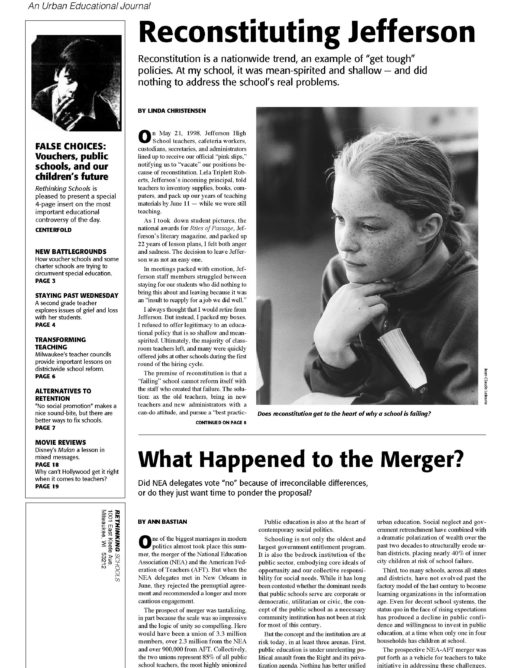Preview of Article:
Reconstituting Jefferson
Reconsitution is a nationwide trend, and example of "get tough" policies. At my school, it was mean-spirited and shallow - and did nothing to address the school's real problems
For years, leaders in the predominately African-American community that Jefferson serves urged school officials to address the crisis of low achievement in the neighborhood’s schools. In June, 1997, in response to those concerns, outgoing Superintendent Bierwirth announced plans to reconstitute Humboldt Elementary, a Jefferson feeder school, and to put Jefferson High School on notice of reconstitution. The moves were part of a “get tough” districtwide strategy to raise test scores at schools that received the lowest numbers on the state tests.
Speaking at the opening faculty meeting in September, 1997, Superintendent Bierwirth discussed the problems he saw at Jefferson. He noted that the majority of freshmen enter the school without passing the Graduation Standards Test (an eighth grade exit exam) in math and reading. He also noted that 84% of Jefferson’s juniors did not meet benchmarks on the state reading test and 85% did not meet benchmarks on the state mathematics test.
Bierwirth put us on notice, but failed to give us criteria for improving the school. He didn’t say, “Bring up those 10th grade test scores by x% or improve student attendance by x%.” Instead, Jefferson’s administrators were asked to design a new plan for the school to implement the following school year, in 1998-99.
But instead of implementing a new plan, we were “fired” later that spring by interim Superintendent Diana Snowden, hired after Bierwirth took a job with the national Outward Bound program. Snowden, a former power company executive with no experience in education, continued Bierwirth’s “policy” of reconstitution.
But reconstitution was not the answer to Jefferson’s problems. It was a quick-fix solution, one that too many urban school districts use to solve complex problems in low-achieving schools and, at least in the case of Portland, to placate communities frustrated by low achievement on standardized tests. In Jefferson’s case, this bomb-the-school approach avoided a desperately needed ongoing discussion between staff, community, students, and administration of the school’s problems – and successes. And it hid the long-standing administrative policies that contributed to Jefferson’s difficulties.</p

